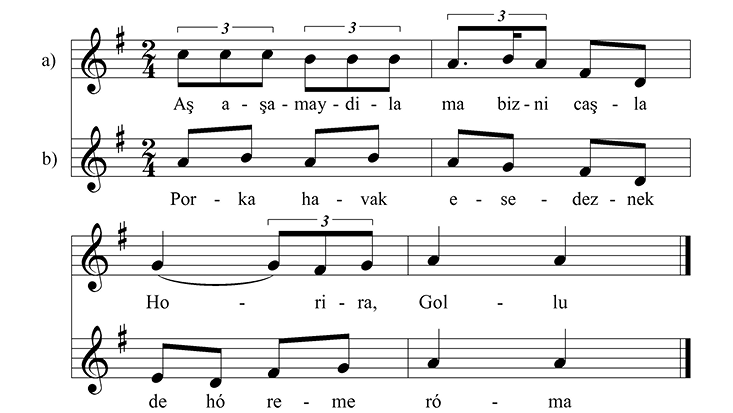- Karachay folk music
- Special tunes
- The classes of Karachay folk music
- Class 1: Rotating and plagal motion (№ 1−8)
- Class 2: One or two short lines and their variations with x(1)1 cadences (№ 9-37)
- Class 3: Four short lines with (1) main cadence (№ 38-53)
- Class 4: Four short lines with the first line ending on the key note, with a (pseudo) domed structure and 1(x)y cadences (№ 54−62)
- Class 5: Four short lines with (VII) main cadence (№ 63−70)
- Class 6: Four short lines with (2) and (b3) main cadences (№ 71−105)
- Class 7: Four short lines with (4/5) main cadences (№ 106−115)
- Class 8: Four short lines with (4/5) main cadence and a higher beginning (№ 116−138)
- Class 9: Four short lines with (7/8) main cadences (№ 139−145)
- Class 10: One- or two-lined tripodic tunes (№ 146–186)
- Class 11: Tunes with four tripodic lines (№ 187–199)
- Class 12: Jir tunes (№ 200–278)
- Class 13: Four long lines with arched (domed) structure (№ 279–287)
- Connections between Hungarian and Karachay folk music
The classes of Karachay folk music
Let us take a closer look at the tune classes and groups one by one. I give a short description of each of them with some examples. This will give the reader a glimpse of the most important tune forms of Karachay folk music. If one have listened and learnt the examples in the analysis part, he won’t come across striking novelties in Karachay folk music any more. Obviously, all the subtle characteristics of Karachay folk music will reveal themselves to those who study carefully the appended scores and listen to all the tunes on the e-book.
Class 1: Rotating or plagal motion (№ 1−8)
Class 1: Rotating or plagal motion (№ 1−8)
Archaic tunes of diverse origin are gathered in Class 1. It includes tunes rotating round the middle tone of the E-D-C trichord (№ 1), some leaping round the notes of the B-A-E, tritone (№ 8) and some with descending-ascending plagal motion (№ 2-5, Ex.1). What they share in common is being different from the majority of Karachay tunes that are built of descending or convex lines. It is noteworthy that the motif rotating round its mid-tone is a basic pattern of Hungarian children’s songs, and the tune that ends rising is a major form of Hungarian regölés. The relevances to Hungarian folk music will be explicated in detail in the chapter “Connections between Hungarian and Karachay folk music”.

Ex.1. a) Descending-ascending Gollu tune of the old religion,
b)
Hungarian regös tune (MNT II, № 866)
